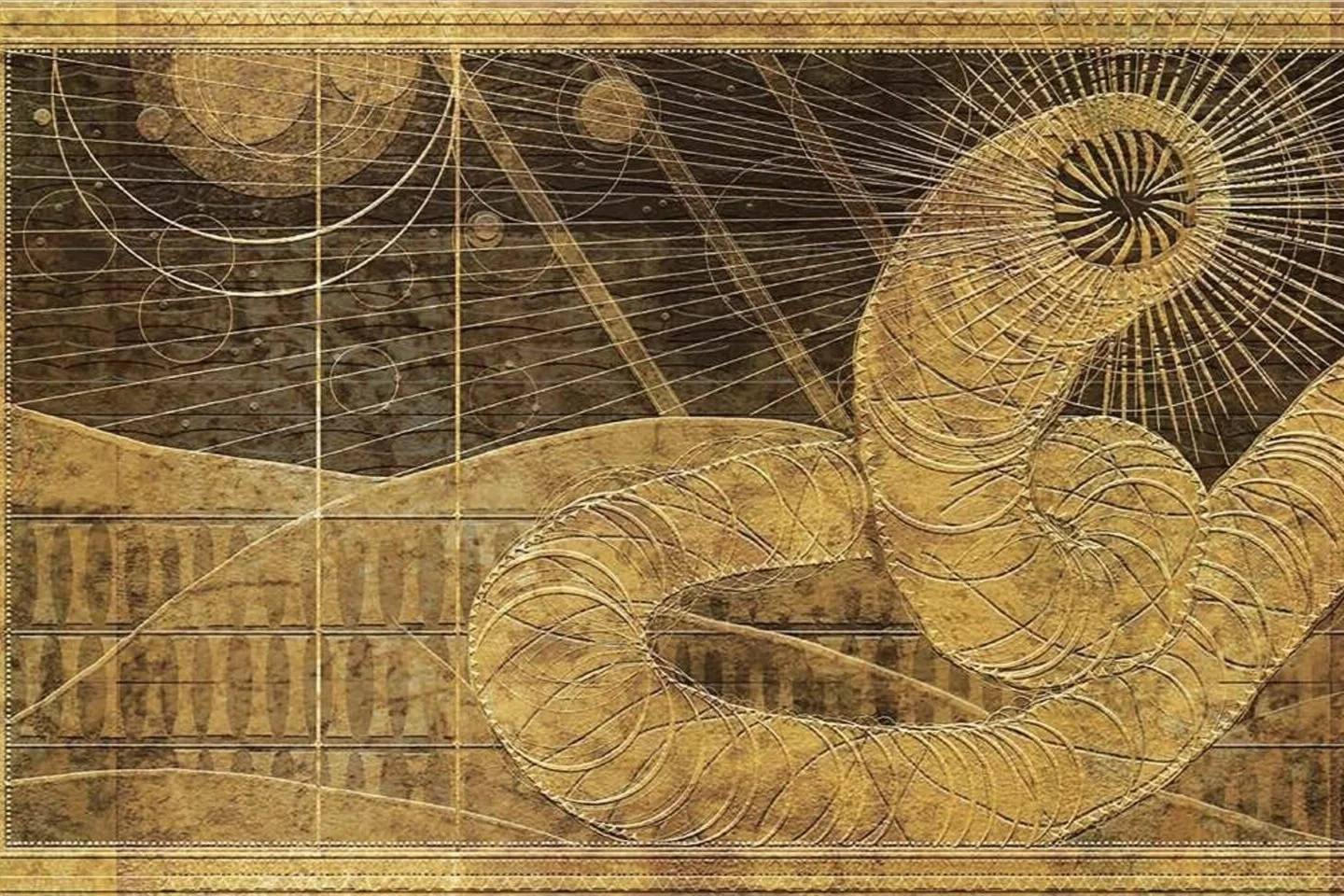Transhumanism & Deification
May 1, 2025 | By Gavin Susantio YDS ‘25
The Art and Soul of Dune Cover Page Mural, 2021
Transhumanism is the future of human transformation—or rather human evolution, as many transhumanist movements call it. But what exactly is transhumanism? In fact, the word “transhuman” comes from a Christian epic from the 13th century, Dante’s Paradiso. [1] You might’ve heard of Dante’s Inferno, which is part of the epic trilogy of Dante’s journey through the underworld, purgatory, and the heavens.
In this article, I would like to explore the religious undertones and general trajectory of transhumanism, as well as Dante’s vision of transhumanism that Christianity offers and safeguards. The latter is traditionally called deification.
Let’s begin with the definition and example of transhumanism in another piece of literature, Frank Herbert’s Dune, followed by the vision of transhumanism in Paradiso, and why human limitations and human deification are both essential and beautiful in the Christian view of the world.
PART I: TRANSHUMANISM IN DUNE
In the Duniverse, AI has been destroyed and strictly banned for 10,000 years. Through AI, technological progress took over moral progress, and the universal command for humanity is “thou shalt not make a machine in the likeness of a human mind.” [2] Strikingly, I realized that humans are making themselves in the likeness of machines and towards a “transhumanist” world.
There are, for instance, three special kinds of humans that evolved throughout the 10,000 years after the war against AI portrayed in the Dune novel:
The Reverend Mothers who possess the memories of their female ancestors and can manipulate others with heightened powers.
The Mentats who can process and calculate vast amount of data in seconds (they’re basically human calculators).
The Guild Navigators who are mutated individuals able to navigate time travel and capable of a high degree of prescience.
This is a telling picture of the human desire to become transhuman or post-human, to go beyond what is possible and to be “like gods.”
Whether some of us in the real world would counteract this movement by embracing the amish way or the status quote, there will inevitably be technological progress. Civilization will not be reserved, and neither will attempts to accelerate human evolution. So, if we ever reach a point in our evolution that resembles the characters of Dune, humans would become more dangerous than ever, even without machines. We might destroy ourselves and our world.
Since the transhumanist movement is broad and diverse in the real world, I will present the three pillars of the transhumanist vision:
Extropianism (directed evolution)
Immortalism (indefinite life extension)
Singularitism (technological singularity) [3]
And in some versions, there is the addition of
4. Technogaianism (earth restoration) [4]
These pillars have religious, or even Christian, undertones: extropianism aims towards the end of suffering; immortalism the hope for eternal life; and singularitism and technogaianism reflect a fascination with the “end times.”
According to the transhumanist movement, to become transhuman is to transform ourselves into becoming more human (by evolving into better humans), but one could argue that we are instead becoming more than human. And transhumanism seems to be our inevitable future, as it was in Dune.
But with technological progress comes technological dangers. Technological progress should be accompanied by moral progress—or in fact “always be subordinated to moral progress.” [5] However, moral progress does not only concern safety but also, in the Christian lifeview, sanctification—i.e., the spiritual progress towards becoming holy or godly. This is where Dante’s Paradiso comes in.
PART II: TRANSHUMANISM IN DANTE
For Dante, the human body is sacred. Yet we are meant to be “deified” or to become God, which some take to mean disregarding the body, since God is immaterial. We are to be transformed into the divine. But how is it that if the human body is sacred, we must become God? Doesn’t that mean to become transhuman is to become more than human?
I maintain that for Dante, (A) becoming more human vs. (B) becoming more divine is a false dichotomy. Deification is for all of us. And deification doesn’t mean fusion with God (in terms of compromising our human nature by being infused with the divine nature), nor dissolution of our nature, but rather union with God. A vs. B is a false dichotomy not only in Paradiso but also in Christianity, because deification is union and participation in God who is Christ. And Christ is both the fullness of humanity and divinity. In the words of Athanasius, a 4th-century theologian, “God became man so that man may become God.” [6] In other words: God’s incarnation as Christ enables our transformation into becoming like Christ, the God-Man.
In Paradiso, Dante has journeyed through Inferno and Purgatorio, which together explore deification as an allegory of the soul’s journey through the underworld to confront its moral failings and purging itself of vice and habituating its counter-virtues through Mount Purgatory. As Dante ascends through the heavenly spheres in Paradiso, he encounters the lives of saints that have been deified or perfected by divine grace, reflecting the divine glory more intensely as he goes further up and further in. Paradise offers a stunning depiction of human being transformed into a state of divine glory.
In this sense, Christian transhumanism is deification, and deification is the process of becoming more like God. And to become more like God means to become more like Christ—who is both human and divine. We see this realized in Paradiso, where heaven is populated with deified human beings. The saints portrayed in the epic are humans who have obtained godlikeness, life eternal, alleviation of suffering, and a restored world. If you notice, this description mirrors the pillars of transhumanism—extropianism, immortalism, singularitism, and technogaianism.
700 years after Dante coined the word “transhuman,” despite its original reference to religious transformation, the utopian depiction of our technological transformation still holds true.
PART III: HUMAN LIMITATIONS AND HUMAN DEIFICATION
Humans, by nature, are limited: we live, and we die. Even in living, we don’t have the powers of evolved human beings in Dune. Both transhumanism in Dante and in Dune grapple with human mortality and limitations.
However, there is a radical difference between the Way of Paradiso vs. the Way of Bene Gesserit.
In Dune, transhumanism is driven by sheer willpower to transcend human limitations, using technological and genetic manipulation. The Bene Gesserit and their Kwisatz Haderach sought mastery over nature—and even fate. However, this unchecked ambition often leads to dystopian and catastrophic outcomes
In contrast, Dante’s Paradiso offers a different vision of transformation. Immortality and technological progress are not inherently bad, but they must be pursued in ways that affirm human dignity and uphold the sacrality of the body. Technological progress must go hand in hand with moral progress towards humility, charity, and ethical living. The lives of saints in Paradiso exemplify how moral progress must triumph and guide humanity. Otherwise, we’d get the fall of the Kwizats Haderach in Dune: Messiah, where technological singularity outruns altruistic singularity. [7]
Dante’s vision, however, is not just about morality or progress. It’s about being like Christ and united to Christ. The Duniverse is a warning against messianic figures and totalitarian power, yet the Gospels present Christ (meaning “messiah” in the original Greek, Christos) as the opposite. Christ’s arrival is one of humility, born in poverty, in a world where the emperors of Rome divinized themselves and executed Christ.
To imitate Christ, then, is not about making a technological leap. It’s a moral and spiritual journey—a process of growth that aligns human nature with a divine order. It’s not about mastering or controlling divine power. It’s not about playing God or manipulating nature that compromises our humanity. It’s partly about recognizing the moral and spiritual costs of transhumanism—when the time comes—and to pursue the moral and spiritual elevation that comes with deification. And it’s about beauty in the struggle to become godlike.
Transhumanism doesn’t address the human condition in full because it tends to merely focus on the external or the mechanical. Deification, on the other hand, redeems both soul and body in a holistic way. The body is glorified but not discarded.
As II Peter 1:3-4 says,
His divine power has granted to us all things that pertain to life and godliness, through the knowledge of Him who called us to His own glory and excellence, by which He has granted to us His previous and very great promises, so that through them you may become partakers of the divine nature, having escaped from the corruption that is in the world because of sinful desire.
Sinful desire is an effect of humanity’s fallen state. While transhumanism seeks to overcome humanity’s limitations, it risks perpetuating a kind of immortal fallenness—even if it alleviates suffering. While technological progress has made the world a “better place,” it hasn’t eradicated the immorality and evil that still poison it. So, while humans are naturally inclined towards becoming transhuman, without God or deification, humanity risks steering itself to an unknown future with disastrous consequences.
In Paradiso, Christ appears at the highest point in the heavens, in a glorified human body. This is profound: God sustains and perfects humanity rather than mutating or surpassing it artificially. And reminiscent of Dante’s transhuman saints in Paradiso, the Scriptures also say: “But our citizenship is in heaven, and from it we await a Savior, the Lord Jesus Christ, who will transform our lowly body to be like His glorious body” (Philippians 3:20-21).
Christ’s glorious body is the fullness of divinity and humanity—a perfect union of the material and the spiritual. There is no suffering, no decay, no mortality. In fact, death is no longer the enemy that transhumanism seeks to destroy. Death is rather the path from life to life.
[1] Dante Alighieri. Paradiso, Canto I. c. 1321.
[2] Frank Herbert. Dune. 1965.
[3] This list (not the terms) is adapted from Kateryna Rassudina. “Transhumanism in Russia: Science, Fun or a Threat to Traditional Values?” in Overcoming the Secular: Russian Religious Philosophy and Post-Secularism. Edited by Paweł Rojek. 2015.
[4] James Hughes. Citizen Cyborg: Why Democratic Societies Must Respond to the Redesigned Human of the Future. 2004.
[5] Brian Patrick Green. “A Roman Catholic View: Technological Progress? Yes. Transhumanism? No,” in Religious Transhumanism and Its Critics. Edited by Arvin M. Gouw, Brian Patrick Green, and Ted Peters. 2022.
[6] Athanasius, On the Incarnation. 4th century AD.
[7] I borrowed this language from Amanda Stoel. “The Meme of Altruism and Degrees of Personhood,” in The Transhumanism Handbook. Edited by Newton Lee. 2019.

